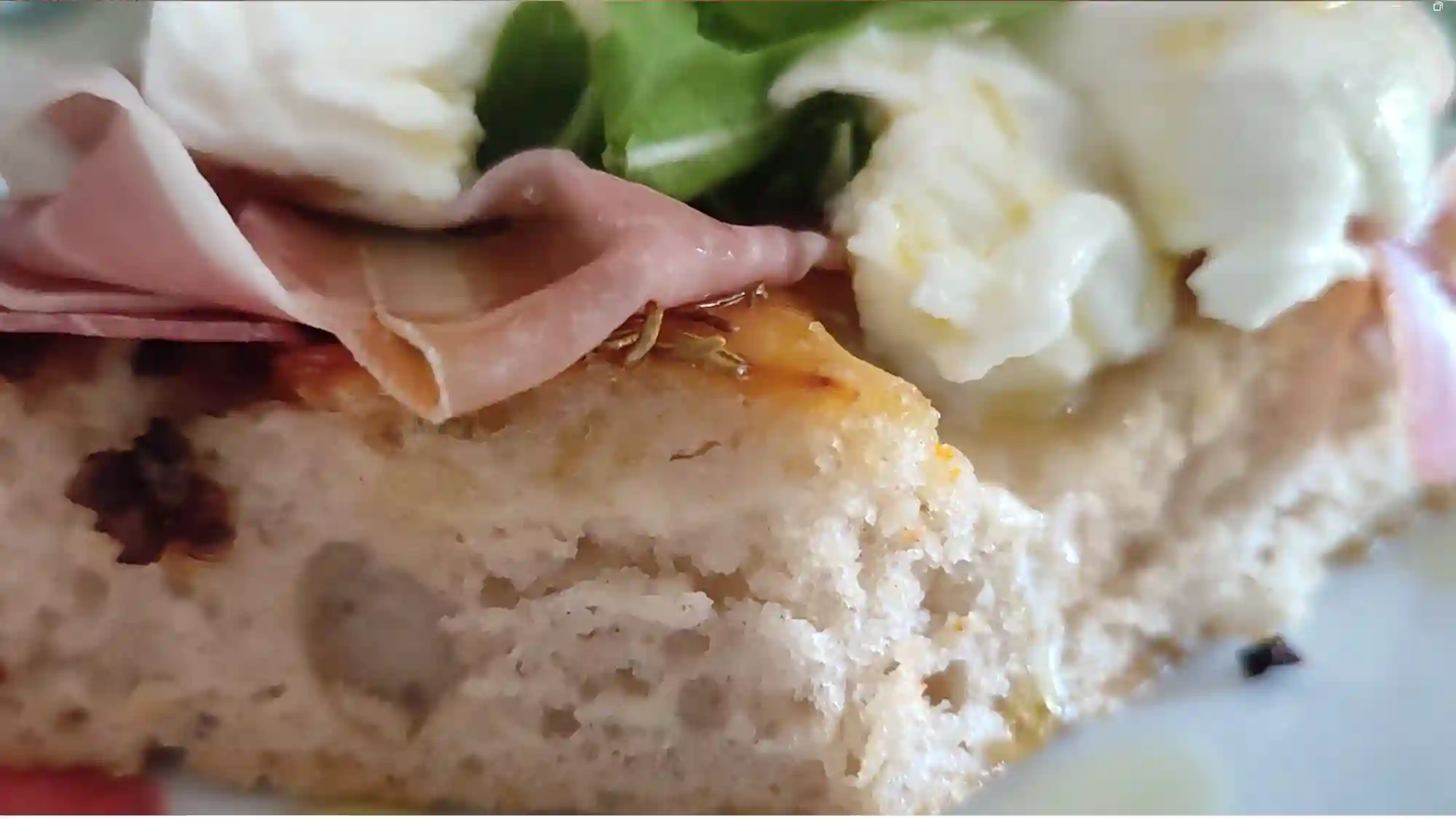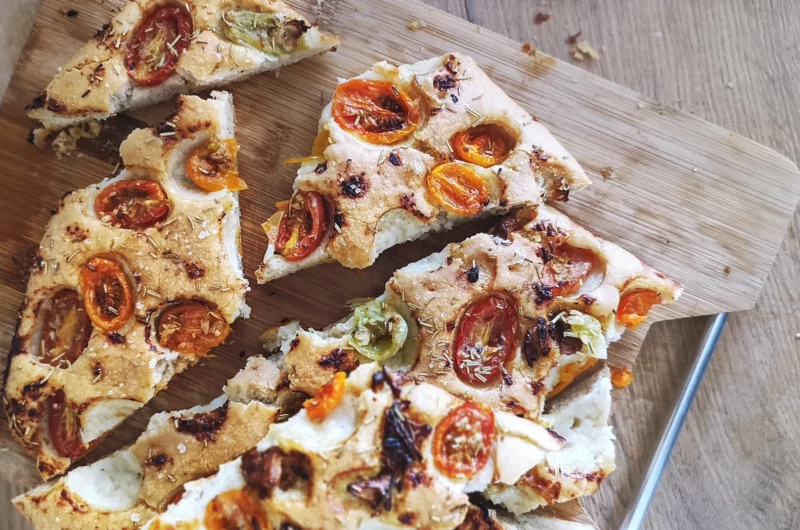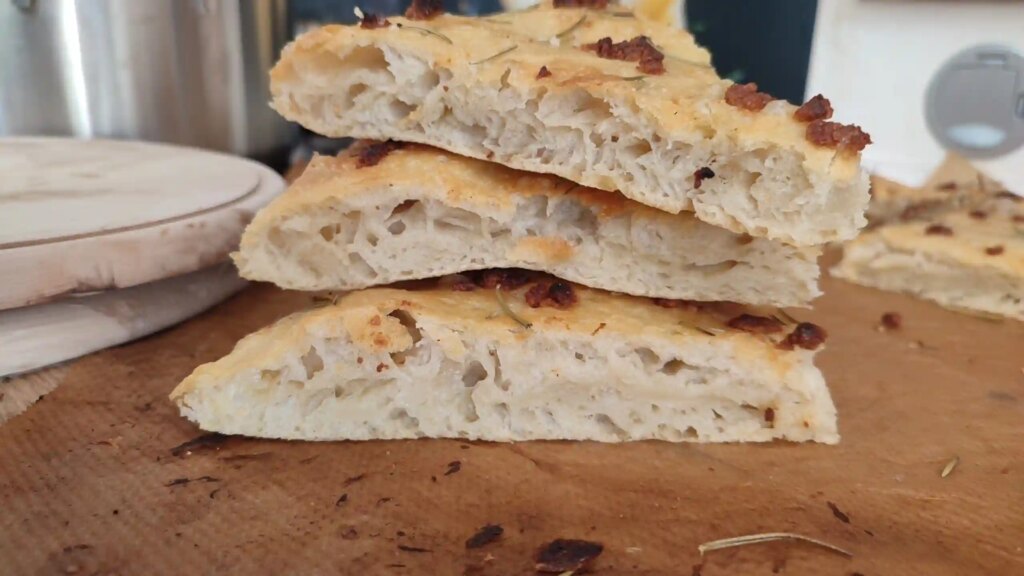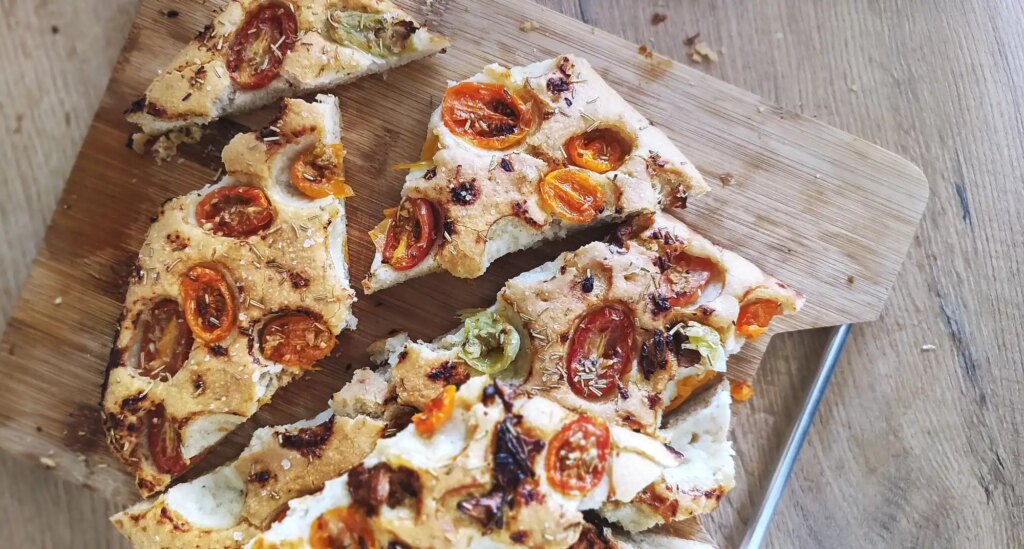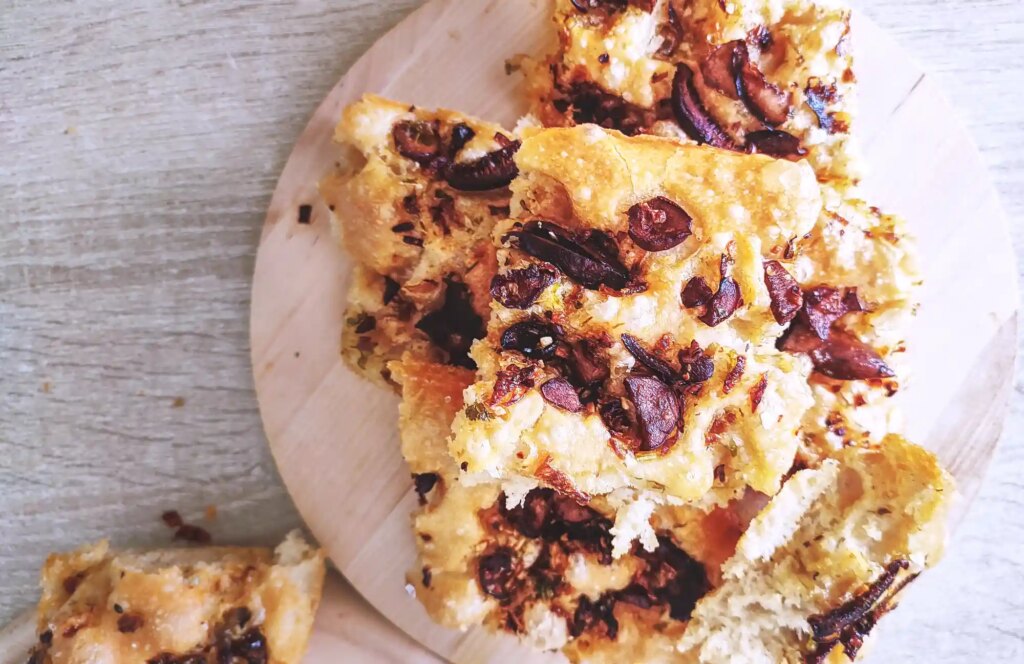In this recipe, I’ll show you how to make a turbo-tasty spelt flour homemade focaccia bread. Below the recipe, I will soon be presenting different topping ideas: mushroom topping (Lactifluus volemus and Chanterelle mushrooms), sun-dried tomatoes and juicy cherry tomatoes. Stay tuned.
Table of Contents
Jump to Recipe
This tasty flatbread is originally from Italy, but has become popular all over the world because of it’s soft middle and crusty crunch.
The top of the focaccia is filled with delicious herbs, olive oil and sometimes vegetables or cheese. All those flavours make it smell so good! The inside is nice and soft and a little moist – like a thick pizza crust. But it’s the texture that makes focaccia so special.
It’s got a light, airy bread-like texture on the inside, surrounded by a thin, crispy outer crust. This combination of light and crispy is sooo hard to resist!
Homemade Focaccia Bread is very versatile! You can eat it on its own, use it to make great sandwiches, or even get creative and use it as a base for a pizza. It also goes great with soups and salads. And omg, it’s best warm and fresh from the oven. Just talking about it makes me hungry!
Mamma mia! 🙂
The best part? You don’t need to knead the dough at all. This no-knead technique makes it so easy to whip up homemade focaccia bread, you’ll feel like you’re relaxing on vacation in Venice while you do it.
Easy Homemade Focaccia Bread
Difficulty: Easy4
servings15
minutes30
minutes45
minutesIn this recipe, I’ll walk you through how to make a super tasty Homemade Focaccia Bread with Spelt Flour loaded up with earthy mushrooms, fragrant herbs, and juicy tomatoes. Topping instructions below!
Ingredients
7g instant yeast
350 ml (1 and half cup) of warm water
1 full tablespoon of honey
Dinkel flour (Spelt flour) (approximately 500 grams) [roughly 4 cups]
2 teaspoons of salt
Directions
- In a large mixing bowl, combine the warm water, instant yeast and honey. Let sit for about 5 minutes until the yeast is activated and foamy.
- Gradually add the spelt flour to the yeast mixture, stirring all the time. Add 2 teaspoons of salt. Continue to add flour until you have a sticky and slightly moist dough. The exact amount of flour will vary, so adjust as needed, (about 500g (about 4 cups)).
- Cover the focaccia dough and leave in the fridge overnight.
- Take the focaccia dough out of the fridge in the morning. It should now be twice as big, sometimes even three times, depending on the strength of the yeast.
Cover with a spoonful of olive oil and gently fold the dough. We want to cover the whole dough with oil and give it some oxygen. Cover again and leave to rise for 3 hours or until it has doubled in size. - When the dough has risen, lightly punch it down and transfer it to a greased baking tray or rectangular baking tin. Using your fingers, flatten the dough to fit the size of the baking tray, making dimples in the dough.
- Cover again and leave to rest while you prepare your easy homemade no-knead focaccia toppings.
- Preheat your oven to 215-220°C (419°F-428°F).
- Spread your favorite topping evenly over homemade focaccia bread. Links to recipes for my favorite topping are below.
- Grind Rock Salt evenly over the homemade focaccia bread, before baking.
- Bake the focaccia in the preheated oven for 30-35 minutes or until golden brown and the topping is slightly crispy.
- Once baked, remove from the oven and allow to cool slightly before slicing and serving. Focaccia is best eaten warm and can be served as a side dish, starter or with your favorite dips and spreads.
- Enjoy your homemade focaccia with your choice of toppings! Recipes for toppings are below.
Recipe Video
Notes
Why Leave the Dough to Hang Out Overnight?
Leaving the dough out overnight is like a secret weapon to take your homemade focaccia bread from great to greatest!
Giving the yeast all those hours to work really intensifies the flavors and makes the bread nice and airy. But most importantly!! – letting it sit overnight actually makes it easier on your stomach to digest.
The yeast breaks down the gluten much better while it’s chilling out and resting for longer periods of time. So do yourself a favor and plan ahead to let the dough enough time to do wonders for awesome flavor and happy digestion!
So grease up those pans and get excited to make this yummy homemade focaccia bread!
Home-made focaccia bread can be combined with many different ingredients. You can be as creative as you like. Think of it like pizza, anything goes.
Here are just a few suggestions, you can use them as inspiration or as a recipe to follow. Let your imagination run wild 😉
Toppings Suggestions for Homemade Focaccia Bread
FAQ about Homemade Focaccia Bread
What’s the secret to making great focaccia?
Unlike more complex breads, focaccia thrives on a few key elements. First and foremost, quality olive oil is essential; it not only imparts flavour, but also contributes to the coveted tender yet crunchy texture. Secondly, the dough needs time to develop. While this recipes calls for a double rise, even a single, slow rise in the fridge can produce equally delicious results. Finally, don’t be shy about your toppings! Whether you prefer classic rosemary and sea salt or more adventurous choices, toppings are where you can get creative and add your personal touch.
What makes focaccia bread different from other types of bread?
Focaccia stands out in the bread world for its distinctive texture and flavour. Unlike standard bread, focaccia is characterised by its dimpled surface, which creates pockets for the olive oil to collect, resulting in a rich, savoury flavour. Focaccia is also incredibly versatile; it can be enjoyed plain with a drizzle of olive oil and a sprinkling of sea salt, or topped with a variety of ingredients such as herbs, vegetables or even cheese.
Does focaccia dough need to rise twice?
Focaccia dough does not necessarily need to rise twice. A single rise can produce excellent results, especially if a slow overnight rise is used in the refrigerator
This longer, slower rise allows the dough to develop flavour and texture without the need for a second rise. However, the double rise in focaccia recipes serves several purposes. Firstly, it allows the yeast to ferment, which enhances the flavour, and the first rise relaxes the dough, making it easier to handle.
Secondly, after shaping, the second rise strengthens the gluten structure, making the dough lighter and more airy. This results in the characteristic open crumb and tender, chewy texture of focaccia. In addition, this longer fermentation period contributes to a complex flavour profile. Finally, it can increase digestibility by breaking down complex starches and proteins, which is particularly beneficial for those with mild gluten sensitivities.
If you’re short on time or prefer a quicker process, a single rise at room temperature will work just fine, even without prolonged figerator fermentation. The key is to let the dough rest and rise until it’s about doubled in size, whether it’s a single or double rise, to achieve the perfect focaccia texture.
Should focaccia be thick or thin?
The thickness of focaccia is a matter of personal preference, and both thick and thin varieties have their virtues.
Traditionally, a classic focaccia is often about 2.5 – 4 cm (1 to 1.5 inches) thick, providing a satisfying combination of crisp exterior and soft, airy interior. Experiment with different thicknesses to find your favourite version of this popular bread.
What country is famous for focaccia?
While focaccia is enjoyed in many forms throughout the Mediterranean region, it is particularly famous in Italy. Italians, like many cultures, have a deep love of bread and focaccia holds a special place in their culinary heritage.
Focaccia’s simplicity and versatility make it a popular staple in Italian cuisine. It can be enjoyed as a quick snack, as a side dish or even as a meal when filled with a variety of toppings.Whether it’s the classic rosemary and sea salt version or a more elaborate creation with olives, tomatoes or cheese, focaccia provides a canvas for culinary creativity.Its roots date back to ancient times around the Mediterranean, and today it remains a cherished part of Italian gastronomy, often served in homes and local bakeries throughout the country.
What country invented focaccia bread?
If you’re visiting Croatia, don’t go if you haven’t tried Komišku pogaču 😉
The invention of focaccia bread is attributed to ancient civilisations around the Mediterranean, making it difficult to pinpoint a single country as its origin. It has its roots in regions such as Italy, Greece and the wider Mediterranean, where flatbreads have been made for thousands of years. The word ‘focaccia’ itself comes from the Latin ‘focus’, meaning hearth or place for baking. Over time, different cultures and regions have developed their own variations of focaccia, resulting in the wide range of recipes and flavours we enjoy today.
Are pizza dough and focaccia dough the same?
Pizza dough and focaccia dough share some ingredients: flour, water, yeast and salt. The main differences are in texture and preparation. Focaccia dough is typically more moist and contains more olive oil, giving it a softer, chewier texture and a distinct flavour. Pizza dough, on the other hand, is usually drier and requires less oil, resulting in a crispier crust. While both are derived from basic bread dough, these variations in ingredients and cooking techniques create the unique characteristics that distinguish focaccia from pizza. So while they’re close cousins in the world of bread, each has its own delicious personality.

